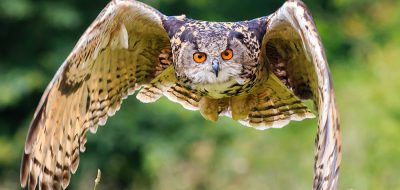In last Saturday’s Owl Prowl post I wrote about going on an Owl Prowl, a night time search for owls. This week I continue with more on the perfection of the owl design.

In addition to big, light-gathering, eyes, an owl’s flight technology was also designed with efficient hunting in mind. High-tech feathers on their broad wings actually muffle the sound of the air rushing over the wings, adding the element of surprise to the prey and allowing the owl to still hear sounds from the prey while in flight.
 The Great Horned Owl, America’s largest, achieves a length of almost two feet, and uses the aerodynamic lift of its nearly six-foot wingspread to swoop down on its prey almost soundlessly. In fact, owls at night move so silently, they can be downright spooky. Sitting by our fire one dark night,
The Great Horned Owl, America’s largest, achieves a length of almost two feet, and uses the aerodynamic lift of its nearly six-foot wingspread to swoop down on its prey almost soundlessly. In fact, owls at night move so silently, they can be downright spooky. Sitting by our fire one dark night,
a great horned owl sailed through our vision, a shadow passing across the barely lighter sky, and disappeared into an oak tree. So soundlessly did it pass, that we weren’t sure if it was an apparition or our imaginations until we heard its haunting hoot.
This mystical creature of the darkness—one of 19 owl species in North America–was revered in Native American myths and legends. Cherokee shamans valued Eastern Screech-Owls as consultants since they felt that owls could punish them by making them sick. A Navajo legend says that the creator told the owl after creating it, “. . . in days to come, men will listen to your voice to know what will be their future.” The Cree people believed Boreal Owl whistles were the spirits calling to them, and if one answered with a similar whistle and did not get a response, he would soon die. Tlingit warriors believed that hooting as they ran into battle would not only give them courage, but also strike fear into the hearts of their enemies.
 If you’ve ever seen a cottontail’s nervous, panicky reaction to the hoot of an owl, you can certainly understand the value of a good hoot. Though hooting is how we identify the call of a great horned owl, hooting is not common to all owls and is not the only sound they make. Owls possess a wide array of vocalizations, including whistles, screeches, screams, purrs, snorts, chitters, and hisses.
If you’ve ever seen a cottontail’s nervous, panicky reaction to the hoot of an owl, you can certainly understand the value of a good hoot. Though hooting is how we identify the call of a great horned owl, hooting is not common to all owls and is not the only sound they make. Owls possess a wide array of vocalizations, including whistles, screeches, screams, purrs, snorts, chitters, and hisses.
Owls often use their hoot call for territorial claims and sometimes in courting. If you hear more than one owl hooting, you can sometimes determine the male by his usually lower pitched hoot. When threatened, they can also produce a clicking sound with their tongues.




